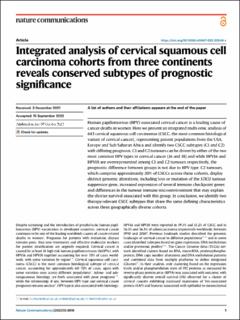| dc.contributor.author | Chakravarthy, Ankur | |
| dc.contributor.author | Reddin, Ian | |
| dc.contributor.author | Henderson, Stephen | |
| dc.contributor.author | Dong, Cindy | |
| dc.contributor.author | Kirkwood, Nerissa | |
| dc.contributor.author | Jeyakumar, Maxmilan | |
| dc.contributor.author | Rodriguez, Daniela Rothschild | |
| dc.contributor.author | Martinez, Natalia Gonzalez | |
| dc.contributor.author | McDermott, Jacqueline | |
| dc.contributor.author | Su, Xiaoping | |
| dc.contributor.author | Egawa, Nagayasau | |
| dc.contributor.author | Fjeldbo, Christina Sæten | |
| dc.contributor.author | Skingen, Vilde Eide | |
| dc.contributor.author | Lyng, Heidi | |
| dc.contributor.author | Halle, Mari Kyllesø | |
| dc.contributor.author | Krakstad, Camilla | |
| dc.contributor.author | Soleiman, Afschin | |
| dc.contributor.author | Sprung, Susanne | |
| dc.contributor.author | Lechner, Matt | |
| dc.contributor.author | Ellis, Peter J. I. | |
| dc.contributor.author | Wass, Mark | |
| dc.contributor.author | Michaelis, Martin | |
| dc.contributor.author | Fiegl, Heidi | |
| dc.contributor.author | Salvesen, Helga | |
| dc.contributor.author | Thomas, Gareth J. | |
| dc.contributor.author | Doorbar, John | |
| dc.contributor.author | Chester, Kerry | |
| dc.contributor.author | Feber, Andrew | |
| dc.contributor.author | Fenton, Tim R. | |
| dc.date.accessioned | 2023-01-19T08:08:07Z | |
| dc.date.available | 2023-01-19T08:08:07Z | |
| dc.date.created | 2022-11-21T11:11:46Z | |
| dc.date.issued | 2022 | |
| dc.identifier.issn | 2041-1723 | |
| dc.identifier.uri | https://hdl.handle.net/11250/3044449 | |
| dc.description.abstract | Human papillomavirus (HPV)-associated cervical cancer is a leading cause of cancer deaths in women. Here we present an integrated multi-omic analysis of 643 cervical squamous cell carcinomas (CSCC, the most common histological variant of cervical cancer), representing patient populations from the USA, Europe and Sub-Saharan Africa and identify two CSCC subtypes (C1 and C2) with differing prognosis. C1 and C2 tumours can be driven by either of the two most common HPV types in cervical cancer (16 and 18) and while HPV16 and HPV18 are overrepresented among C1 and C2 tumours respectively, the prognostic difference between groups is not due to HPV type. C2 tumours, which comprise approximately 20% of CSCCs across these cohorts, display distinct genomic alterations, including loss or mutation of the STK11 tumour suppressor gene, increased expression of several immune checkpoint genes and differences in the tumour immune microenvironment that may explain the shorter survival associated with this group. In conclusion, we identify two therapy-relevant CSCC subtypes that share the same defining characteristics across three geographically diverse cohorts. | en_US |
| dc.language.iso | eng | en_US |
| dc.publisher | Nature Research | en_US |
| dc.rights | Navngivelse 4.0 Internasjonal | * |
| dc.rights.uri | http://creativecommons.org/licenses/by/4.0/deed.no | * |
| dc.title | Integrated analysis of cervical squamous cell carcinoma cohorts from three continents reveals conserved subtypes of prognostic significance | en_US |
| dc.type | Journal article | en_US |
| dc.type | Peer reviewed | en_US |
| dc.description.version | publishedVersion | en_US |
| dc.rights.holder | Copyright The Author(s) 2022 | en_US |
| dc.source.articlenumber | 5818 | en_US |
| cristin.ispublished | true | |
| cristin.fulltext | original | |
| cristin.qualitycode | 2 | |
| dc.identifier.doi | 10.1038/s41467-022-33544-x | |
| dc.identifier.cristin | 2077129 | |
| dc.source.journal | Nature Communications | en_US |
| dc.identifier.citation | Nature Communications. 2022, 13, 5818. | en_US |
| dc.source.volume | 13 | en_US |

